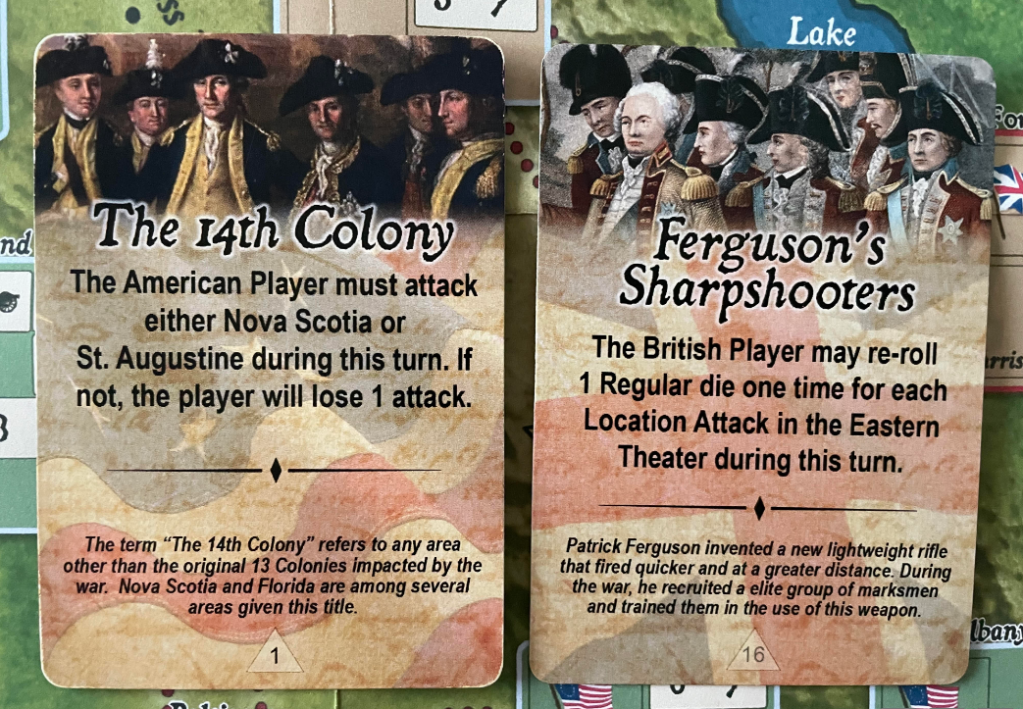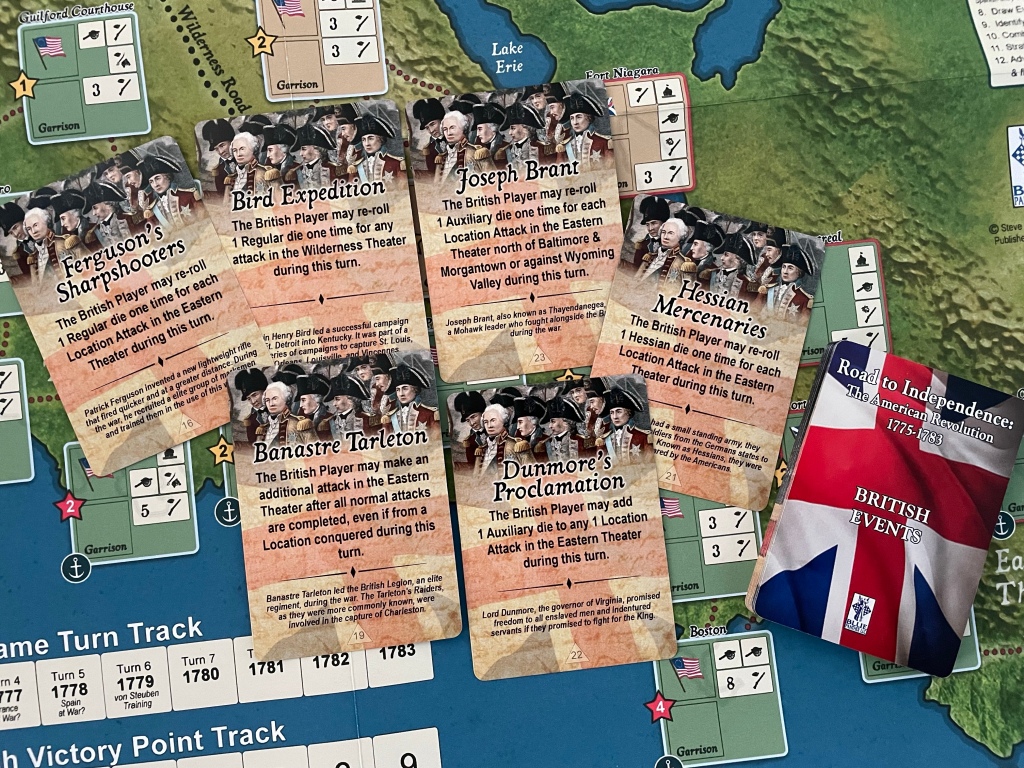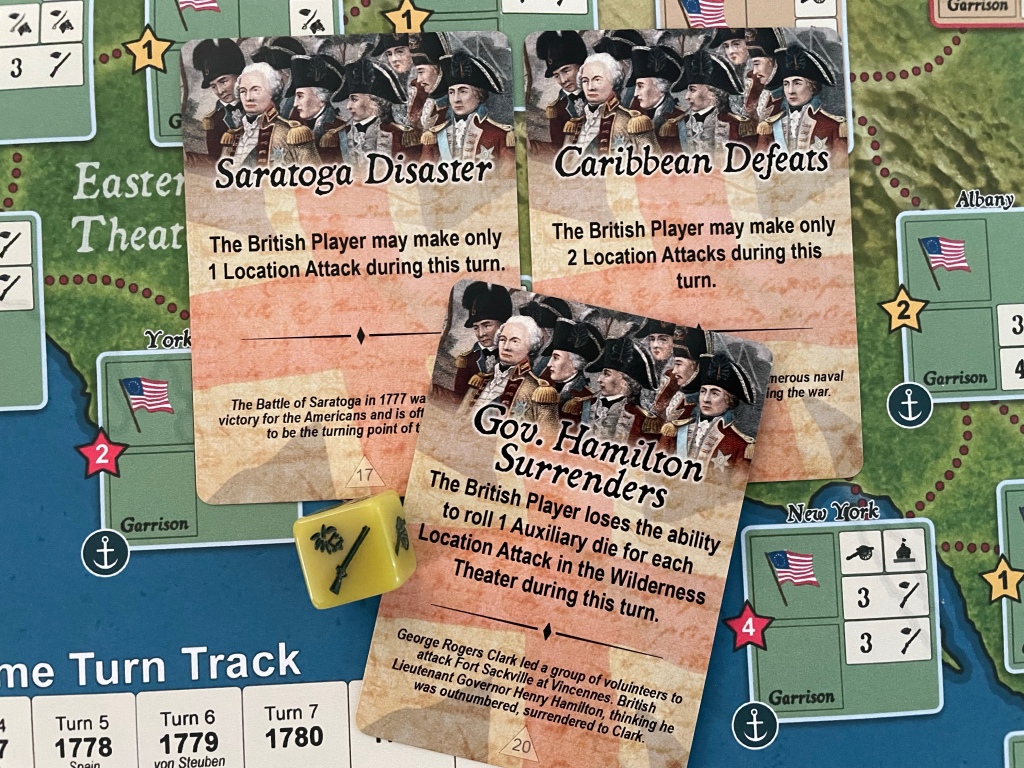Not every wargame has to be deep. Some of them are light and fast playing and are just fun and interesting to experience. But, with this lightness, that doesn’t mean that the game isn’t a good representation of the history or an interesting play experience. Such is the case with a new game called Road to Independence: The American Revolution, 1775-1783 from Blue Panther.
Road to Independence: The American Revolution, 1775-1783 is the second in a planned series of games that will simulate various important conflicts in American history in a casual format. The first game was called French & Indian War from The Historical Game Company and the third game will cover the American Civil War. In this game, two players clash and take the sides of the British or the Americans fighting over the control of the Thirteen Colonies. One of the interesting things about the game is that it not only includes the Eastern seaboard but also the conflict in the far Western territory, a theater not often covered in games on this conflict. Both players will fight for control of important locations using specially made dice that represent British and American regulars, Native American allies, militia units, and (for the Americans) French and Spanish forces. Each player also has their own deck of Event Cards that will allow special events and actions to occur, ensuring that no two games will play the same.
In Action Point 1, we looked over the Game Board and discussed the two theaters depicted including the Wilderness Theater and the Eastern Theater and their differences. In Action Point 2, we took a look at the Location Cards and their use. In Action Point 3, we discussed the various different custom dice and what units they represent and how they are used in the game. In this Action Point, we will take a look at the Event Cards and their effects.

Event Cards
Each player has access to a deck of 15 different Event Cards. At the start of the game, the players will create their Event Card Deck by randomly drawing 10 of the 15 Event Cards. This means that not every card will be used in every game and this provides some different effects and opportunities with each play. At the beginning of each player’s turn each round, they will draw one Event Card from their deck. The Event Cards are the designer’s method of introducing historical events and figures to the narrative and is a really nice choice for the game as it creates some interesting advantages that mimic the fortunes and occasional luck of war.
Let’s take a look at the anatomy of these Event Cards.

In the picture above, we have an American Event on the left and a British Event on the right. At the top of the card is a historical picture just above the title of the card. After the title is the Event text which instructs the player how the card works and what effect it might have. Below the Event text is historical flavor text that will give a setting and some context for the Event.
These Event Cards are very straightforward and have effects that reflect the history of the period. Some of these Events are better than others and have game changing effects where some are more utilitarian and have a beneficial use that might have conditions or requirements.
Let’s take a look at a few examples. The first Event Card we will examine is called Surprise Attack and is a very powerful card for the American player. The effect of the Event allows the American player to simply place a Control Marker and remove any British Garrison Counter from any Location in the Wilderness Theater. The one requirement is that the Location targeted must be connected to an American Location. Remember, that a connection can be via a River or a Trail/Road.

This is a very powerful card because it takes a Location from the British and doesn’t count against the 3 Attack limit per turn so the American player can Attack 3 additional Locations and make a huge dent in the British Victory Points. This is the only Event Card like this in the game and the British have nothing quite like it.
There are really several different types of Events at the players disposal, including Events that allow for re-rolls of dice during an Attack, substitution of types of dice and several different types of negative effect cards that take away Attacks or cause the loss of a die. Remember that each player is allowed 3 Attacks per turn and losing one or two of these can be very bad.

These negative Events can be really inopportune if they happen at the wrong time but the players have to expect them and plan around them. I do really like the historical ties to the Event Cards as you can see below, these British negative effect cards are associated with key battle losses, such as in the case of Johnny Burgoyne’s defeat at the Battle of Saratoga as well as British defeats in the Caribbean and the loss of Fort Sackville at Vincennes.

Each of the sides has the same number of negative effect Event Cards with 5 each. So in this regard, there is no difference between the sides. But, as mentioned before, the Americans have the best single Event Card in the game (Surprise Attack) I would say that they have the card advantage in this one. But, remember that because only 10 random Event Cards are used per game on each side, there is a chance that this game changing card will be left out of the game.

I think that the Event Cards are a nice addition to the game and keep the game, which is very lite and focused on lots of dice rolling, grounded in the history of the American Revolution. The effects are a bit of a mixed bag as some are more useful and beneficial than others but they definitely keep the game interesting and inject a bit of the unknown into the experience.
In case you are interested, we also posted an interview with the designer Steven Kling and you can read that at the following link: https://theplayersaid.com/2023/09/18/interview-with-stephen-l-kling-jr-designer-of-road-to-independence-the-american-revolution-1775-1783-from-blue-panther/
If you are interested in Road to Independence: The American Revolution, 1775-1783, you can order a copy for $60.00 from the Blue Panther website at the following link.
In Action Point 5, which is the conclusion to this series, we will discuss the victory conditions and examine which side has the trickier time of achieving theirs.
-Grant
